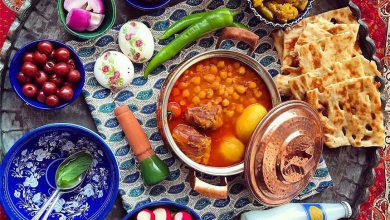A Culinary Journey through Iran: Exploring the Rich Tapestry of Persian Cuisine
Exploring the Rich Tapestry of Persian Cuisine
Introduction:
Iran is well known for its rich and varied food. It is a country rich in natural beauty, historical history, and a centuries-old cultural tapestry. Persian food blends tastes from the Mediterranean, the Middle East, and Central Asia, reflecting the nation’s geographic diversity. This essay takes readers on a delicious culinary tour of Iranian cuisine, examining the common ingredients, well-known recipes, and subtle cultural differences that make eating Persian food special and enjoyable.
1. Rice, the Heartbeat of Iranian Cuisine:
Rice is the foundation of Iranian cuisine, serving as a culinary canvas that is painted with a multitude of flavors and textures. Steamed rice, or chelo, is a mainstay of Iranian cuisine. Because of its simplicity, this grain may be coupled with a variety of stews and kebabs, demonstrating its flexibility. Another well-liked rice dish is polo, which combines a delicious assortment of foods including meats, veggies, and herbs to create a visual and gastronomic symphony.
2. Kebabs, a Culinary Symphony:
The world over, Iranian kebabs are regarded as a culinary gem because of their unique tastes and succulent texture. Jujeh Kebab is a popular dish, especially on festive occasions, and it consists of marinated and grilled chicken. The minced beef kebab known as koobideh is a prime example of Persian chefs’ skill in combining herbs and spices. Barg, a lamb or beef fillet kebab, is a great example of the taste and suppleness that come from careful cooking.
3. Ghormeh Sabzi, the National Stew:
Ghormeh Sabzi, a green herb stew having a particular place in Iranian hearts, must be included in any discussion of Iranian cuisine. Ghormeh Sabzi is a dish that combines a variety of herbs, red beans, and meat (usually lamb or beef) to create a fragrant and flavorful explosion that perfectly captures the spirit of Persian cookery. It’s a classic Iranian comfort food, especially when served with aromatic rice.
4. Fesenjan, a Culinary Symphony of Sweet and Savory:
A classic Persian stew known as fesenjan is proof of the delectable fusion of salty and sweet tastes found in Iranian cooking. Pomegranate paste, ground walnuts, and fowl (usually duck or chicken) combine to make a silky, creamy meal. Fesenjan’s tart and sweet flavor complements the complex taste of Persian cuisine.
5. Dolma, a Mediterranean Influence:
Dolma, a delectable dish made from rice, minced beef, and herbs, is filled inside grape leaves and serves as a testament to the Mediterranean influence on Iranian cooking. Dolma is a culinary masterpiece that showcases the variety of Iranian culinary influences and the nation’s historical ties to surrounding areas. It may be served as both an appetizer and a main meal.
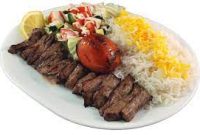
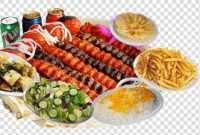
6. Iranian Bread Varieties:
In Iranian cooking, bread, or “Nan,” is essential. Thick and topped with sesame seeds, barbari is a favorite for breakfast, frequently paired with cheese, tea, and herbs. Other kinds that adorn Iranian tables include Taftoon, Lavash, and Sangak, highlighting the essential role that bread plays in Iranians’ everyday life.
7. Sweets and Desserts:
“Shirini,” or Iranian candies, are a delicious way to end any Iranian dinner. Persian sweets are known for their craftsmanship and intricate flavors. Two examples include Gaz, a nougat and pistachio delicacy, and Baklava, a layered pastry filled with honey and almonds. Deep-fried pastries steeped in syrup flavored with saffron, called zoolbia and bamieh, are celebratory foods consumed on special occasions.
8. Herbs and Fresh Ingredients:
In Iranian cooking, fresh herbs such as mint, parsley, coriander, and chives are essential. The tastes of rice dishes, stews, and salads are enhanced by these herbs, which also add to the freshness and energy of Persian cuisine. Iran’s dedication to culinary quality and its wealth in agriculture are reflected in the utilization of fresh, locally produced products.
9. Tea Culture in Iran:
Iranian tea, or “Chai,” is a staple of social occasions and Iranian culture. Iranian tea culture is associated with warmth and friendliness, since it is traditionally sipped leisurely from delicate cups while enjoying conversation and sweets. In Iranian society, tea, served with sugar cubes, is a daily ritual that promotes social interaction.
10. Street Food Delights:
Iranian street cuisine offers a taste of the nation’s varied and vibrant tastes. Dizi, a filling stew made with beef and chickpeas, is a popular street food. A noodle soup with herbs called Ash Reshteh is filling and healthy. Iran’s street food culture is rich, as seen by the true flavor of the country’s cuisine that street sellers provide.
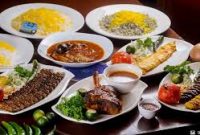
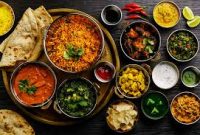
Conclusion:
Iranian food is a sensory extravaganza with a rich history and a wide range of influences. Persian cuisine offers a gourmet voyage through centuries of culinary evolution, from the aromatic rice dishes to the juicy kebabs, complex stews to sweet treats. Iran’s cuisine is a tribute to the nation’s tenacity, inventiveness, and dedication to maintaining the tastes that characterize Persian eating, as it embraces its cultural legacy while changing with the times. Discovering the rich, varied world of Iranian food is a voyage not just via the senses but also into the very spirit of a country that is very proud of both its culinary heritage and its cultural heritage.



